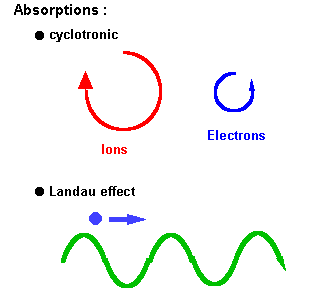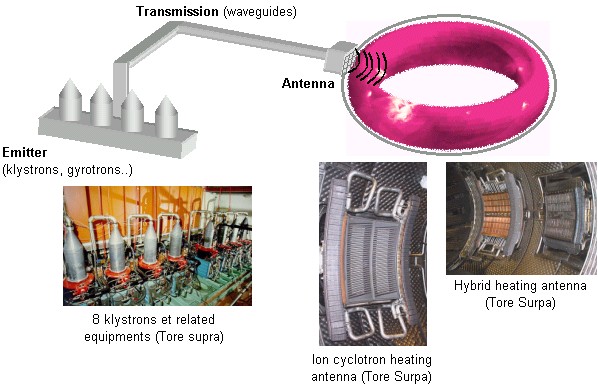|
4) - Heating and current generation
(p 1
- 2 -
3 -
4 -
5 - 6 - 7 )
| Electromagnetic waves are part of our everyday life, from the radio to the
microwave oven. On Tore Supra, a new kind of microwave oven heats up the plasma... |
c) heating by radio-frequency wave
Just like in other fluids, like air or
water,all kinds of waves
 can propagate inside a plasma. This is a large field in plasma physics, since
there is a huge huge wealth of possibilities depending on the nature of the wave (its frequency,
polarisation
can propagate inside a plasma. This is a large field in plasma physics, since
there is a huge huge wealth of possibilities depending on the nature of the wave (its frequency,
polarisation
 ...) and on the plasma properties (density, temperature,...). Waves are generally speaking ranked by family according to frequency and propagationdirection
relative to the magnetic field (parallel or perpendicular). Depending on the latter, the waves may either be propagative or evanescent, may be reflected or change polarisation, may change amplitude in the course of time or, quite the contrary, may transfer energy to the plasma. It is the latter that interests us here, and it is this property that we use to heat the plasma with electromagnetic waves with specifically selected characteristics.
...) and on the plasma properties (density, temperature,...). Waves are generally speaking ranked by family according to frequency and propagationdirection
relative to the magnetic field (parallel or perpendicular). Depending on the latter, the waves may either be propagative or evanescent, may be reflected or change polarisation, may change amplitude in the course of time or, quite the contrary, may transfer energy to the plasma. It is the latter that interests us here, and it is this property that we use to heat the plasma with electromagnetic waves with specifically selected characteristics.
| There are two main mechanisms enabling plasma to gain energy from a wave: cyclotron type absorption and Landau type absorption. In both cases,
the wave-particle interaction is resonant, i.e. they vibrate at the same frequency.
In the case of cyclotron absorption, one
couples to the plasma a wave at a frequency resonating at the rotation frequency
of a species (ions or electrons) in their trajectory around the magnetic field lines.
In the case of Landau absorption, one
couples to the plasma a wave in resonance with a population of particles, in such a way that the wave and particle nearly have the same
velocity propagation. The situation is then more or less comparable to that of a surfer, moving at the same speed as the wave, and taking advantage of its speed.
|

|
In addition to heating the plasma, waves also enable the generation of current. Indeed, in the tokamak configuration, a current flowing in the plasma is used to create the poloidal component of the
confining magnetic field. This current is itself induced by the transformer effect in which the plasma is secondary, from a primary circuit that only has a limited capacity. When the primary circuit has been emptied, there is no more plasma current
, and therefore no more poloidal magnetic field, thus no more confinement: it is
the end of the discharge. On Tore Supra, whose toroidal magnetic field is provided by
superconducting magnets and is therefore permanent, this is one of the main limitations of pulse duration (on the other tokamaks, where the toroidal magnetic field is produced using conventional copper magnets, the toroidal system is also a limitation).
We see therefore the interest in plasma current generation by methods other than the transformer effect: this is what we call non-inductive current generation. This is a field which is very actively explored in Tore Supra, the tokamak specialised in long duration pulses.
To get from the heating effect to the current generation effect, an
directionality effect has to be added to the wave spectrum, so that it only comes to resonate with particles having a preferential
direction. A net impulse transfer is made in the toroidal direction, thus generating a current (since there are "more" charges flowing in one direction than
the other in the toroidal direction; the outcome is therefore a current).
NB : we can also achieve current generation using heating by energetic
particles injection, by directing the beam properly to transmit impulsion to
the plasma particles in the toroidal direction.
Three major families of heating exist, classified according to their range of frequency :
Each type of heating has its own applications, and is capable of providing different results (heating or current generation) according to the way in which it is used.
In any case, the wave is generated by different systems according to frequency (tetrodes or diacrodes for ion cyclotron frequency, klystrons for hybrid frequency, gyrotrons for electron cyclotron frequency), then is propagated to the tokamak by carefully scaled transmission lines (wave guides), and then
is coupled to the plasma by means of an antenna, placed inside the vacuum chamber. Apart from the material problems posed by these sensitive electro-technical systems, the difficulty consists in coupling the wave
to the plasma, involving complex physical processes and requiring proper control of the plasma edge.

|
|